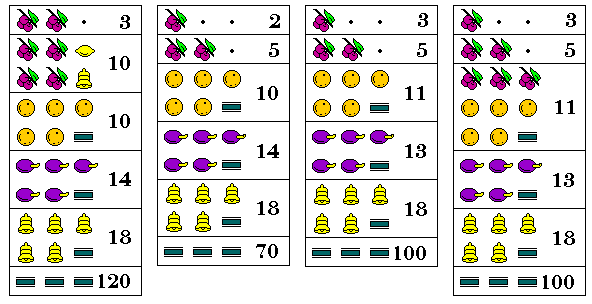
Up to this point, slot machines nearly all paid one prize for two cherries, and a larger prize for two cherries and either a bell or a lemon. As we've seen, this arrangement predates the introduction of fruit symbols on Mills machines, going right back to Charles Fey's original slot machine on which two horseshoes returned the coin played, and two horseshoes and a star paid two coins. But it was the first Mills slot machine that added a payout for two horsehoes and a heart, the symbol taking the role that the bell would later occupy.
The fourth column of the illustration below shows the payout schedule that post-war Jennings machines eventually came to offer, both with an award for one cherry on the first reel, and then two other awards, increasing in size, for two cherries and then all three.

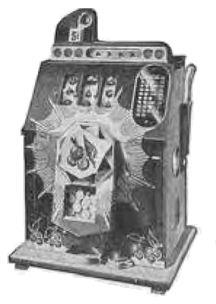
Before slot machines started to give prizes for a cherry on the first reel only, and before they started to have cherries on the third reel, allowing the lemon to be done away with, Mills emphasized the importance of the cherry in a different way with the machine known as the "Bursting Cherry" from 1938.
This machine, pictured at left, had a conventional pre-war payout schedule, except that the award for two cherries and either a bell or lemon was ten coins instead of five, as shown in its payout schedule, in the first column of the illustration above.
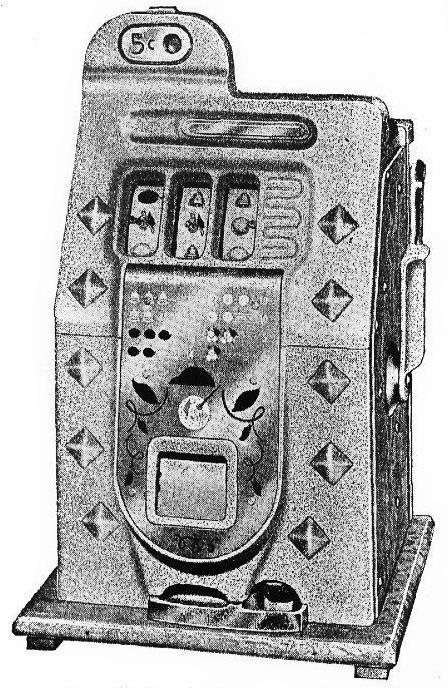
Apparently, the 1939 Mills Chrome Bell slot machine, pictured at right, (often referred to as the Diamond Front) was the first machine to offer payment on one cherry on the first reel only. I have been able, so far, to directly confirm the machine's existence in May 1939 and single-cherry pay being offered on it at least by October 1940. Its payouts are illustrated in the second column of the illustration above.
After the Second World War, some companies sold both old Mills Diamond Front Chrome Bell machines and other Mills Silent Bell machines with cases made to resemble the case of that machine, and those other machines were modified to also have a single-cherry payout.
Also, after the war, the first new Jennings machine was the Bronze Chief, followed by the Super Deluxe Club Chief and then the Standard Chief. These machines were available with several options for their payouts and reel strips, and single-cherry payout was included. This form of payout for those machines is illustrated in the third column of the illustration above. In fact, I have since found an advertisement from September 1939 in which it is noted that the pre-war Super Chief from Jennings is also offered with one-cherry pay as an option. The wording of that advertisement suggests to me that they were offering an alternate payment option because a competing machine - specifically, the Mills Chrome Bell - had already made it popular, so the fact that it pre-dates the earliest mention I could find of the Mills machine's single-cherry pay does not make me doubt that Mills originated it on that machine. Also, while most (but not all) surviving Mills Chrome Bells owned by collectors have single-cherry pay, all the Jennings Super Chiefs that I could find images of had the older double-cherry payouts.
At first, the two payouts, on one cherry and two cherries, simply replaced the former two payouts, on two cherries, and on two cherries with a lemon or bell.

Only a few of the advertisements for the Jennings Super Chief, pictured at left, mentioned the option of single-cherry pay for it. Its primary innovation, however, was prominently featured in all the advertisements for it: an improved slug rejector. They seemed to be so confident in that improvement that the machine did not even have a coin escalator; despite that, Jennings' next machine, the Jennings Master Chief, not only also included a coin escalator, but included a large and bulky coin rejector supplied to Jennings by another company, so apparently their improvements in the Super Chief still fell short of perfection.
In the illustration of the Super Chief on the left, there is something below the payout card which looked as though it might be a round window through which at least the last coin played could be seen, if not a full multiple-coin escalator. However, from photographs of the machine, it appears to be something else; what appears to be a coin showing through a round window is instead a metal projection which would have obstructed the view of a coin behind it. (One possibility is that the merchant has to push it down and see the last coin played behind it, as above the projection there still appears to be a dark area which may be a window, before a larger payout is made by the machine, which would mean that a key or at least a concealed control somewhere would also have to be used.)
Apparently, slugs were a serious problem im late 1939, as Pace also advertised their Rocket Bell as "slugproof", and improved slug rejection was also advertised for jukeboxes by Rock-Ola. Earlier in 1939, Pace offered a version of their De Luxe Comet Bell which also had a large additional slug rejector added, and that too is illustrated below. Like the Jennings Super Chief, it appears to have omitted the coin escalator, and the escalator came back on its successor, the Rocket Slugproof Bell.
Below are illustrated the Jennings Silver Chief from 1937 (but which was still being advertised later on, along with the Jennings Super Chief), the Jennings Master Chief which shortly followed the Jennings Super Chief, the Jennings Silver Moon Chief from 1941, and the Jennings Silver Moon Master Chief:

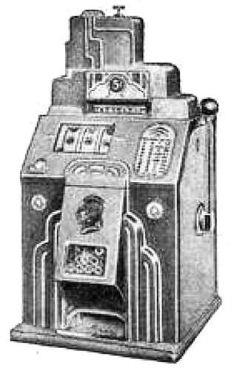

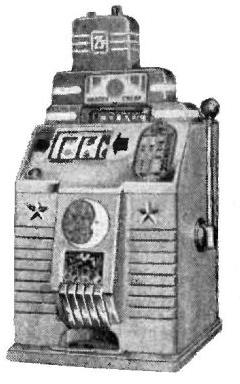
And here are illustrated the Slug Rejector version of the Pace de luxe Comet Bell as well as the Pace Rocket Slugproof Bell:
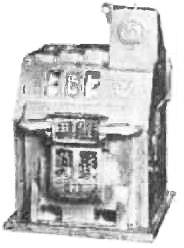
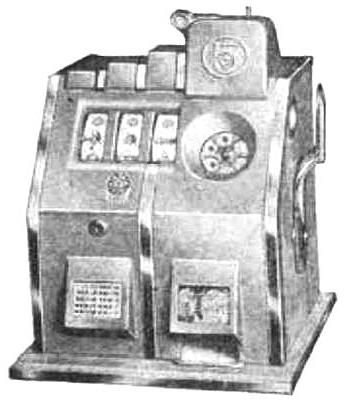
For the Jennings Master Chief, the company turned to a third-party company, National Rejectors Incorporated of St. Louis, Missouri, to supply the "National slug rejector" which, as can be seen, is somewhat bulky and obtrusive in appearance on this machine. While the regular Silver Moon Chief did not include this slug rejector, there was also the Silver Moon Master Chief which did, and both are shown above.
I have learned why slugs were such a serious problem in 1939. It was not until December, 1940 that a court decision found that those who made and used slugs could be convicted under Federal counterfeiting laws. Later, in 1944, Federal legislation specifically dealing with slugs made to defraud vending machines, distinguishing that from counterfeiting, was enacted. Before the 1940 court decision, there were novelty companies openly making slugs, although with denials that they were intended for fraudulent use.
By 1946, Pace was advertising that its machines were available with a choice of payouts, including options where one cherry on the first reel paid 3 coins, and by 1947, Watling was doing so as well, with the option of paying out either 2 coins or 3 coins for a cherry on the first reel. As we will see shortly, both of these companies also moved quickly to offer the option of payouts similar to those of Buckley's Criss-Cross shortly after Jennings came out with their similar Tic-Tac-Toe.
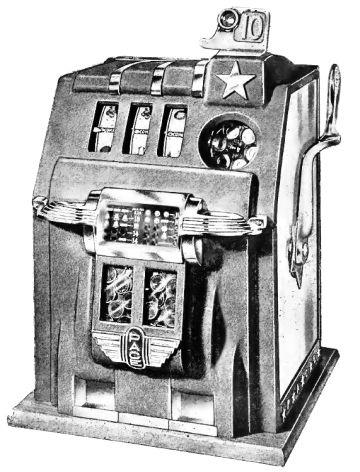
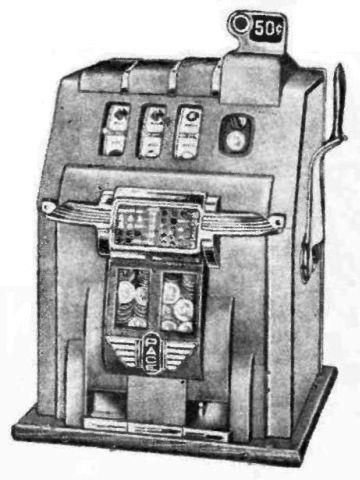
The Pace Deluxe Chrome Bell, pictured at left, and its predecessor, the very similar Pace Deluxe Cherry Bell, pictured at right, illustrate something else about the escalator on slot machines. The Pace Deluxe Chrome Bell pictured here has a circular coin escalator, while the Pace Deluxe Cherry Bell pictured here has a window through which the last coin played can be seen. This is not, however, because the circular coin escalator was introduced with the Chrome Bell; both models were the same in respect of coin escalators or the lack thereof.
Instead, because the 50 cent piece is a physically larger coin than a quarter, it was no longer possible to have the circular coin escalator for that denomination. Both machines were also made in a version that handled silver dollars; there, automatic jackpot payout was also dropped, and instead a gold award token was used.
The earliest slot machines were only made to handle nickels. Some slot machines were available to take pennies; this depended on the date, and the type of machine. From 1930 to 1950, most full-sized slot machines were made in versions that took nickels, dimes, and quarters. The Watling Rol-a-Top was initially made in a model that took pennies as well. Also, on rare occasions during the history of that machine, Watling advertised a 50 cent version of the Rol-a-Top, sometimes noted as available at a higher price. Thus, a 50-cent Rol-a-Top is a rare collector's item.
The same physical considerations that Pace faced also confronted Watling: when it decided to make a machine that took silver dollars for casino use, that machine was a version of its Treasury rather than its Rol-a-Top.
The Jennings Chief and some of its successors during the 1930s were advertised as being available for all denominations from the penny to the silver dollar, and in the early post-war era, Pace advertised its machines as being available for all denominations from the nickel to the silver dollar. Caille, and also Mills, tended not to mention available denominations in their advertisements. However, in the early post-war era, some Mills distributors noted that the pre-war Mills Horsehead Bonus slot machine, to be discussed below, had just become available for the 50 cent coin.
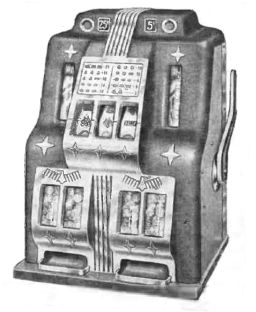
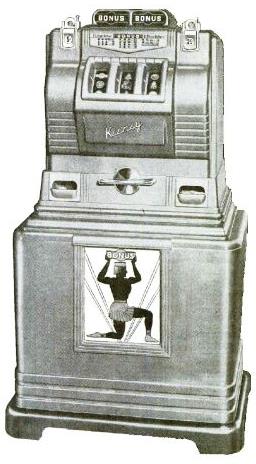
Of course, the first slot machine to accept silver dollars was the Silver Dollar from 1929, a revamp made by Charles Fey; and, of course, it was unfortunately timed, as the prosperity of the Roaring Twenties was about to come to an end with the stock market crash in October of that year.
Some console machines had multiple coin slots, so that one could play either a nickel, a dime, or a quarter, receiving one's prize in the coin that one played. Bally made a countertop slot machine which could take either a nickel or a quarter, the Bally Double Bell, from 1939, shown at left, and this was followed by the Keeney Pyramid in 1950, shown at right, which was a console, but a console in the sense of a floor model of a conventional slot machine like the Caille Commander, rather than a wide machine like the Mills 3 Bells.
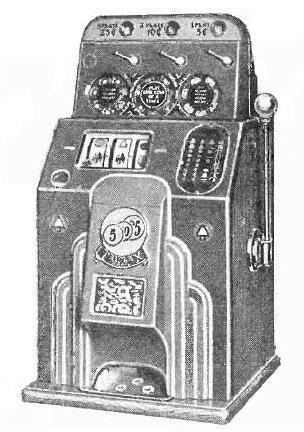
The Jennings Triplex Chief from 1938, pictured at left, tried another approach: it was a nickel slot machine, but playing a dime would let you play twice, and playing a quarter would let you play five times. This turned out to be a mistake; if enough people played dimes and quarters, the machine was likely to run out of nickels.
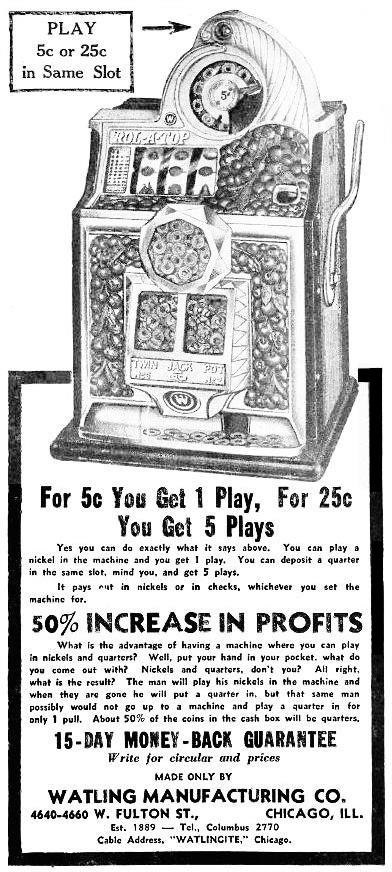
That didn't stop Watling from making the same mistake: a very rare model of the Rol-a-Top could take quarters as well as nickels, and give five plays for a quarter: it was advertised in both the May 7, 1938 and the May 14, 1938 issues of Billboard. Just to show I'm not making this up, the ad is shown on the right.

Incidentally, a rotary coin escalator such as featured on the Pace Deluxe Chrome Bell shown above also appeared on a Pace Operator's Bell from late 1926, illustrated at left (the new 1927 model, this date being visible on the front), so their rotary escalator antedated that of the Watling Rol-a-Top.
In addition to Jennings, Pace also made slot machines for casino use with cherries on the third reel, and this was common on Bally electromechanical slot machines. But neither Mills nor Watling appear to have ever adopted the cherry on the third reel (not counting the Mills QT, of course).

While I am not inclined to count the Mills QT as being the originator or even the inspiration of including the cherry om the third reel as a routine thing on conventional slot machines, as its payout structure was very much unlike that of a conventional slot machine, I have found that a traditional payout schedule (that is, one that does not begin to give prizes for cherries until they appear on the first two reels), but with three cherries and two cherries and a bell giving the next prize after two cherries, was a feature of a conventional slot machine from 1937, the Caille Playboy, pictured at left, which was basically a version of the 1936 Caille Cadet with different payouts.
Advertisements for this machine made it clear what the rationale was for replacing two cherries and a lemon with three cherries was: abolishing the lemon completely from the reels of the machine.

The payout schedules for three machines that introduced changes to the three-reel combinations involving cherries are pictured at right, first that of the Caille Playboy on the left of the image, and then that of Keeny Bonus Super Bell in the center of the image, and finally that of Evans' Lucky Lucre on the right of the image. I am not sure if the two payouts for cherries on the Lucky Lucre are 2 coins and 4 coins, as shown, from the images of that console I have been able to locate. Also, for both machines, I am arbitrarily using 100 coins to represent the jackpot. And unlike the Evans Lucky Lucre, this was indeed specifically done so that the machine would have no lemons anywhere on its reels.
Of course, as this slot machine dates from 1937, its name has nothing to do with the famous magazine founded by Hugh Hefner in 1953.
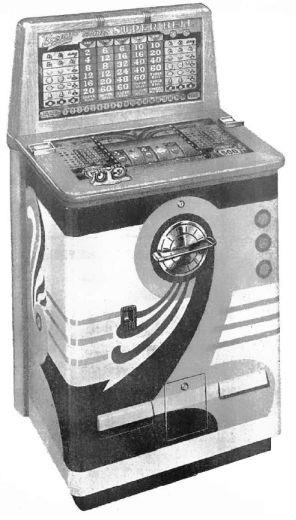
Before I became aware of the Caille Playboy, I learned that a console machine from 1946, the Keeney Bonus Super Bell, pictured at left, had a cherry on the third reel. It did not, however, pay out on a cherry on the first reel only, but it did have one payout for cherries on the first two reels, and a larger one for cherries on all three reels. While the Caille Playboy of 1938 anticipated it in putting cherries on the third reel, and paying out specifically on three cherries, in one respect this was closer to the more modern payout schedules with three cherries in that it did not also include the older cherry-cherry-lemon payout.
I had thought that subsequently, it became the norm to allow a bar on the third reel to substitute for a cherry on the third reel as with other symbols, but I see I was mistaken: that did not happen, not even in the electromechanical era. However, one console machine, the Evans Lucky Lucre, from 1939, which had a traditional payout structure, paying one prize for two cherries, and a larger prize for two cherries and a bell, also paid that latter larger prize for two cherries and a bar, rather than acknowledging lemons on the machine at all.
Also, I have since learned that payouts on one, two, or three cherries were offered on the Jennings Standard Chief after all, which means that Jennings is likely to have been first with the fully modern payout schedule, and they could have had it by 1946 as well, although at the moment the earliest data I have is 1947.
Ironically, while the Lucky Lucre broke with tradition by changing cherry-cherry-lemon to cherry-cherry-bar, so that its payout schedule would neither create a need for lemons, nor admit to the presence of lemons, an image of the reel bundle for that machine reveals that it did indeed have lemons on both the first and third reels.
While I hadn't seen any indication of this in contemporary advertising, after seeing one Jennings Standard Chief from 1947, claimed to have its original payout card and reel strips, with payouts on one, two, or three cherries, I have searched for images of other Jennings Standard Chief machines on the Web, and found several others with that payout arrangement.
As well, while changing from the traditional payout on two cherries or two cherries and an additional symbol to payout on one or two cherries can be done by simply bending back a payout finger in addition to changing reel strips and payout discs appropriately, changing to pay on one, two, or three cherries requires a fundamental addition to the mechanism.
Thus, Jennings definitely appears to have originated the modern payout structure with prizes on one, two, or three cherries, and it appears to have existed from the early post-war era: previously, I had despaired of narrowing it down to any time before the introduction of the Jennings Buckaroo.
Repeating the earlier image of slot machine payouts through the years for ease of reference, since we are once again returning to refer to it:
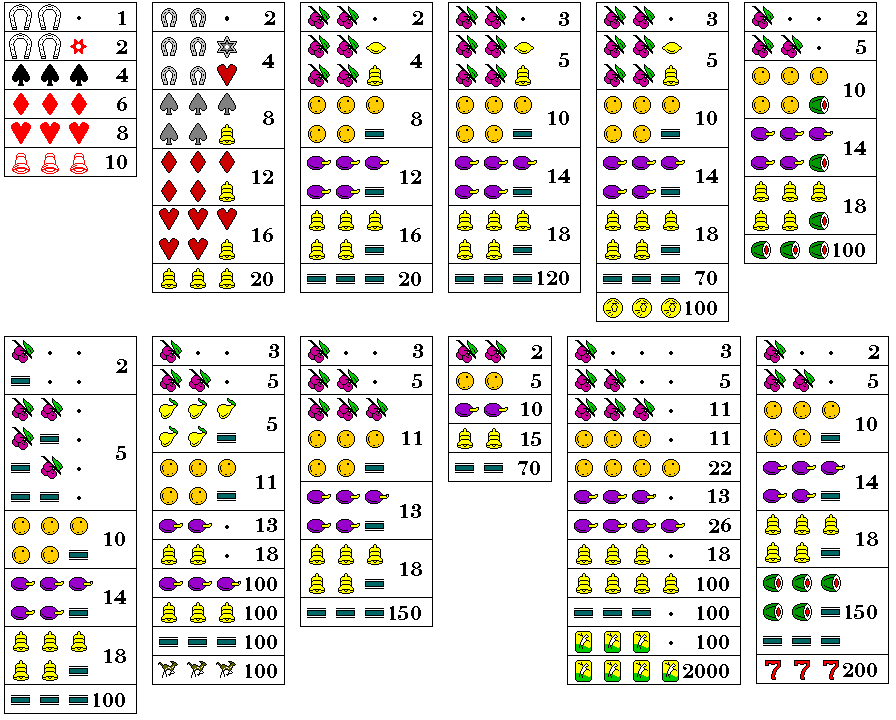
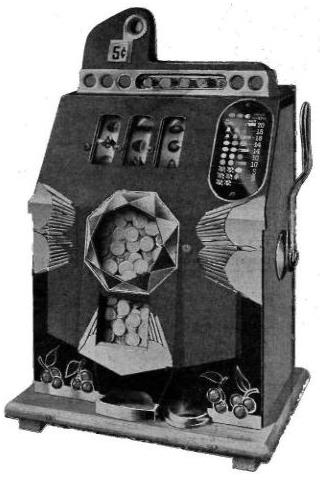
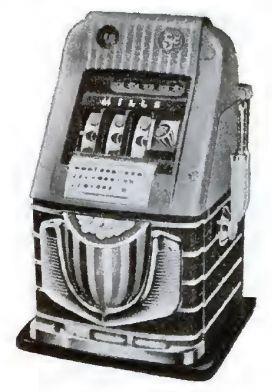
The sixth arrangement shown on the first row shows the payouts of one version of Mills' Melon Bell machine. Here, the new symbol, a half-watermelon, simply replaced the bar, as can be seen from the fact that it can complete three oranges, three plums, and three bells. The original Mills Melon Bell, which came out in 1937, did not have a payout for a single cherry on the first reel; its case design was similar to the "Bursting Cherry" style of machine. Pictured at left is the original version, at right the "hi-top" version from 1948.
The window to the jackpot compartment replaced the cherry prominently featured on the case of the Bursting Cherry version of the Mills slot machine.
I have been able to verify, from some Mills advertising literature (which is better left undescribed in certain aspects) displayed in a forum post, that Mills did indeed intend the melon symbol to represent a watermelon; and looking things up on Wikipedia convinced me that at least arguably a watermelon is a true melon alongside the honeydew melon and the cantaloupe.
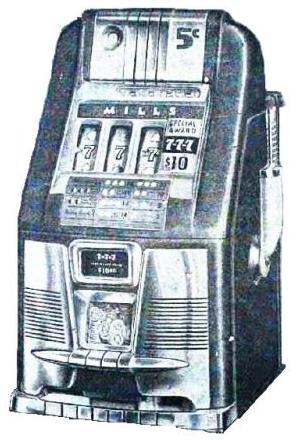
Now we will look at the 21 Bell slot machine, also known as the 7-7-7 HiTop machine, which had a few positions on the three reels where a 7 was overprinted on another symbol, so that any winning combination either symbol might make would pay out.
(*) Lemons - - 5 (%) Cherries 3 6 - (O) Oranges 5 4 2 (@) Plums 8 3 3 (A) Bells 1 5 8 (C) Melons 1 1 1 (=) Bars 2 1 1 (7) Sevens 1 1 1
Although it does not affect the odds, the 7 on the first reel was overprinted on a plum, the one on the second reel was overprinted on an orange, and the one on the third reel was overprinted on the bar.
Again, an alternate version of the first reel was available for a less generous payout; it had three lemons on the first reel, replacing two plums (including the one overprinted with a 7) and one of the bars.
Given the payout schedule:
%.. 2 %%. 5 OOO, OO= 10 @@@, @@= 14 AAA, AA= 18 CCC, CC=, === 120 777 200
its percentages can be calculated as follows:
Reel Combinations Value Amount
1 2 3 Paid
5 * 14 * 20 = 1400 * 2 = 2800
5 * 6 * 20 = 600 * 3 = 1800
5 * 4 * 3 = 60 * 10 = 600
8 * 3 * 4 = 96 * 14 = 1344
1 * 5 * 9 = 45 * 18 = 810
1 * 1 * 2 = 2 * 120 = 240
1 * 1 * 1 = 1 * 120 = 120
1 * 1 * 1 = 1 * 200 = 200
----
7914
As this gives an even lower profit of 1.975%, which would seem to be impractical for any slot machine, even in a major casino, I can only conclude that I have misunderstood my sources of information. Cutting the jackpot in size from 100 coins to 50 changes the percentage to 2.95%, still extremely low.
In John Scarne's Complete Guide to Gambling, a detailed description is given of a Mills 21 Bell machine with a modified payout schedule and modified reel strips used in the Nugget casino in Reno. On this machine, there was a 7 on its own on the first reel; as in the regular Mills 21 Bell, the 7 was overprinted on an orange on the second reel, and on a bar on the third reel. But in addition, a bell and bar were overprinted on the first reel, a plum and bar along with a melon and orange in two positions were overprinted on the second reel, and a melon and orange were overprinted in two positions on the third reel. (Overprinting the melon and orange on the second and third reel makes me wonder if there is a connection to the Jennings 7-1-1 slot machine, where the Indian head, an additional jackpot symbol similar to the melon, can substitute for an orange on the last two reels.)
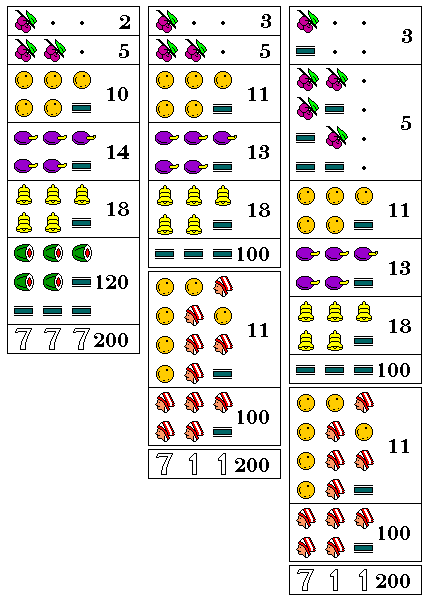
Recently, I came across a listing for a Jennings Standard Chief slot machine which had the number 7 overprinted on a symbol on the first reel, and the number 1 overprinted on a symbol on each of the second and third reels. Having those numbers appear, spelling out 7-11, on the pay line gave a large jackpot.
Perhaps this was Jennings' answer to Mills' 21 Bell slot machine, or it could have been a customization performed by one particular casino. But it certainly would make sense, given Jennings' use of 7 and 11 on the Jennings Sweepstake Chief, that they used 7 and 11 as a motif on other machines.
I have now found two other examples of this kind of machine. One was a Sun Chief model from 1949 instead of a Standard Chief, and it was in use at the Flamingo. The other was also a Standard Chief, but instead of having the extra 7-11 jackpot added to a conventional payout schedule, it had it added to a Tic-Tac-Toe payout schedule.
Also, in both cases, the images were more detailed, allowing me to see that in addition to the jackpot for the superimposed 7-1-1 numbers, there were additional prizes involving an additional symbol on the reels: an Indian head.
The payouts of the Mills 21 Bell, along with both variants of the payout for this machine, are shown at right.
How could such a generous payout schedule be profitable?
The one with payouts added to a Tic-Tac-Toe payout schedule looks particularly daunting, so for our example, let us choose the simpler case shown on the left of the diagram.
Let's start with an actual set of reel strips for the original payout schedule (V12-55-3), exclusive of the additions that make the machine a 7-1-1 slot machine. This set is said to have a modest payout percentage of 75%.
(*) Lemons 4 0 5 (%) Cherries 2 6 0 (O) Oranges 5 5 3 (@) Plums 5 3 3 (A) Bells 1 5 8 (=) Bars 3 1 1
For the second and third reels, the obvious step that suggests itself would be to take one orange on each reel, and change it to an Indian Head; this would leave the amount paid for three oranges unchanged.
On the first reel, there are three bars; change one of those to an Indian Head, and the amount paid for jackpots is unchanged.
And adding a single jackpot of 200 coins to a machine with a house advantage of almost 25% by overprinting those digits on one symbol on each reel would not make it unprofitable.
Thus, the reel strips might have the following contents:
(*) Lemons 4 0 5 (%) Cherries 2 6 0 (O) Oranges 5 4 2 (@) Plums 5 3 3 (A) Bells 1 5 8 (=) Bars 2 1 1 (4) Heads 1 1 1
with the payouts calculated as follows:
Reel Combinations Value Amount
1 2 3 Paid
2 * 14 * 20 = 560 * 3 = 1680
2 * 6 * 20 = 240 * 5 = 1200
5 * 5 * 4 = 100 * 11 = 1100
5 * 3 * 4 = 60 * 13 = 780
1 * 5 * 9 = 45 * 18 = 810
2 * 1 * 1 = 2 * 100 = 200
1 * 1 * 1 = 1 * 100 = 100
1 * 1 * 1 = 1 * 200 = 200
----
6070
for a payout percentage of 75.875%.
So, not only is it feasible to make a profitable arrangement, but it isn't even necessary to go to such extremes as having ten oranges on the third reel and ten plums on the second reel, as on some other Jennings machines. However, having lemons on the first reel - and on the third reel, where they are no longer used - is unfortunate, it must be admitted.
It may, however, be possible not to have any lemons, other than the one on which the 7 on the first reel is overprinted. All the melons on the second and third reels of the modified 21 Bell at the Nugget casino in Reno that Scarne wrote about were overprinted on oranges, so they could be replaced by Indian heads, and the 7 that stands on its own on the first reel could be overprinted on that reel's only lemon.
A Jennings 711 designed on that basis could have its symbols distributed this way on the reel strips:
(*) Lemons 1 0 4 (%) Cherries 2 6 0 (O) Oranges 5 3 2 (@) Plums 7 3 3 (A) Bells 1 5 8 (=) Bars 2 1 1 (4) Heads 2 2 2
this will have a higher percentage than the machine described by Scarne, since while the combinations with an overprinted melon and orange would still be present in effect, due to the payouts involving the Indian head and the orange, and the overprinting of 7s would also correspond to the overprinting of 1s on the second and third reel, there would be nothing corresponding to the overprinting of a bell and a bar on the first reel, or an overprinting of a plum and a bar on the second reel.
Rather surprisingly, it turns out that this distribution of symbols is very similar to the one I came up with above by starting with an ordinary Jennings set of reel strips.
The payouts may be calculated as follows:
Reel Combinations Value Amount
1 2 3 Paid
2 * 14 * 20 = 560 * 3 = 1680
2 * 6 * 20 = 240 * 5 = 1200
5 * 5 * 5 = 125 * 11 = 1375
7 * 3 * 4 = 84 * 13 = 1092
1 * 5 * 9 = 45 * 18 = 810
2 * 1 * 1 = 2 * 100 = 200
2 * 2 * 2 = 8 * 100 = 800
1 * 1 * 1 = 1 * 200 = 200
----
7357
giving a payout percentage of 91.96%, as opposed to 94.45% on the machine that Scarne investigated.

The first arrangement in the bottom half of the illustration is that of the Buckley Criss-Cross. Not shown in the diagram is the most important and unique feature of its payout schedule: if a bar was visible on each reel, whether on the payout line or on the line above or below, a prize of 18 coins would be paid, except of course in the case where the three bars were all on the payout line, in which case a jackpot would be awarded as usual.
The Jennings Tic-Tac-Toe came out shortly after, also incorporating this unique feature. Its payouts were slightly different; a single cherry paid 3 instead of 2, three oranges paid 11 instead of 10, but three plums paid 13 instead of 14. Its original form, as a payout option for the Jennings Standard Chief, is pictured at right. This payout style was also available with later Jennings machines, such as the Sun Chief and the Governor.
One possible arrangement of the contents of its reels are as follows:
(*) Lemons - - 10 (%) Cherries 1 7 - (O) Oranges 10 1 3 (@) Plums 5 1 5 (A) Bells 1 10 1 (=) Bars 2 1 1
Making lemons fully half of the symbols on the third reel seems something of an uninspired expedient to reduce the amount paid, but the standard measure of making symbols common on one reel, and rare on another, seems to have been pushed to its limits here as well. However, in addition to allowing bars to freely replace cherries on the first two reels, this machine also offered an additional payout of eighteen coins if a bar was in any of the three visible positions for all three reels.
With its payout schedule of:
%.., =.. 3 %%., %=., =%., ==. 5 OOO, OO= 11 @@@, @@= 13 AAA, AA= 18 === 150
we can work out how much it pays:
Reel Combinations Value Amount
1 2 3 Paid
3 * 12 * 20 = 720 * 3 = 2160
3 * 8 * 20 = 480 - 2 = 478 * 5 = 2390
10 * 1 * 4 = 40 * 11 = 440
5 * 1 * 6 = 30 * 13 = 390
1 * 10 * 2 = 20 * 18 = 360
2 * 1 * 1 = 2 * 150 = 300
----
5600
Note that while in the first instance, the number of combinations for %%., %=., =%., and ==. is calculated for all 20 symbols on the third reel, for two bars, but not the other combinations of the first two symbols, a third bar does change the winning combination to something else, so those possibilities need to be subtracted.
For the payouts given for bars in other positions, we need to add 52 times 18 coins, or 936 coins, increasing the return on 8000 coins to 6536 coins, for a profit of 18.3%.

This type of payout arrangement has an interesting history. While the Jennings Tic-Tac-Toe machine may be better known, as it was quite successful, and remained in use in casinos around the world for several years, it is not where this style of payout originated.
The Buckley Criss-Cross, pictured at right, was the first machine of this type, being advertised in late 1947.
Note that it closely resembles a Mills Silent slot machine, a line that started from the Mills War Eagle in 1931 and continued to the first post-war Mills slot machine, the Black Cherry; in particular, it strongly resembles both the Chrome Bell (Diamond Front) and the Black Cherry. This is not a coincidence: Buckley was primarily in the business of reconditioning and modifying used slot machines, and so the earliest Buckley Criss-Cross slot machines were Mills slot machines that simply had their reel strips and payout disks modified, as well as being given a new style of case. However, the popularity of the Criss-Cross was such that to meet demand for it, Buckley began manufacturing their own slot machines from scratch, and then noted that its machines were newly manufactured in its advertising.
The similar set of payouts that it offered was:
%.., =.. 2 %%., %=., =%., ==. 5 OOO, OO= 10 @@@, @@= 14 AAA, AA= 18 === 100
with three bars in other positions paying 20 coins.
The symbols on its reels were arranged as:
(*) Lemons - - 6 (%) Cherries 2 8 - (O) Oranges 8 1 6 (@) Plums 8 1 5 (A) Bells 1 9 2 (=) Bars 1 1 1
which arrangement is very similar to that of the related Jennings machine.
Again, we can work out how much it pays:
Reel Combinations Value Amount
1 2 3 Paid
3 * 11 * 20 = 660 * 2 = 1320
3 * 9 * 20 = 540 - 1 = 539 * 5 = 2695
8 * 1 * 7 = 56 * 10 = 560
8 * 1 * 6 = 48 * 14 = 672
1 * 9 * 3 = 27 * 18 = 486
1 * 1 * 1 = 1 * 200 = 200
----
4933
and for the payouts on bars in other positions, now we need to add 26 times 20 coins, or 520 coins. That gives a payout of 5453 coins out of 8000, for a percentage of 31.8375%.
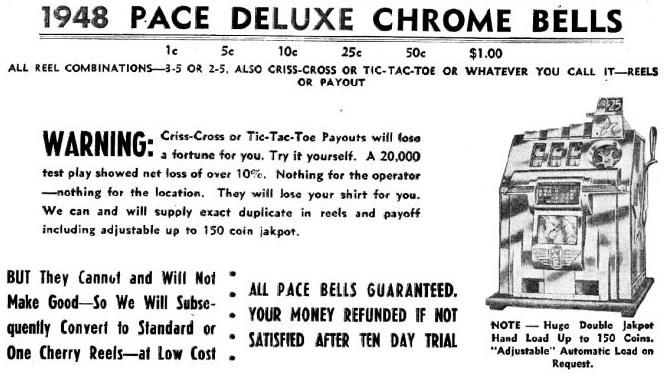
The Jennings Tic Tac Toe slot machine appears to have only come out in 1948, despite some sources ascribing a 1947 date to it. Machines of that arrangement continued to be made by them when Jennings updated the styling of its slot machines in 1949. By that time, both Pace and Watling were also offering similar payout arrangements for their machines as an option, as their advertising noted, although some advertisements by Pace, mentioning this, also recommended against it, for whatever reason. When I wrote that, I had seen advertisements that simply said a criss-cross arrangement was available, but noted "(not desirable)" afterwards; an earlier advertisement, from 1948, shown on the left, makes their reasons explicit; apparently for some reason they couldn't work out how to design reel strips that would remain profitable with such generous payouts (although they claimed to have copied those of their competitors exactly).
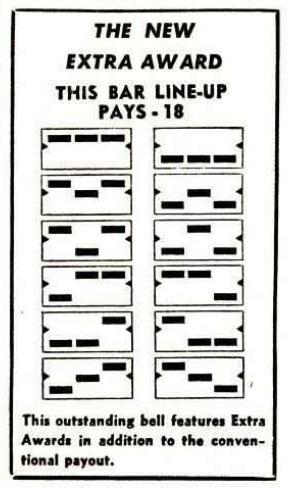
One advertisement for a Watling machine with this feature showed 12 extra payouts it provided: for bars in any position on the middle reels, and in the two positions other than the payline for the first and third reels. The relevant portion of the advertisement is shown to the right.
One early advertisement for the Jennings Tic-Tac-Toe, which appeared in the March 6, 1948 issue of Billboard, stated that there were twelve possibilities, rather than the full 26 which the Buckley Criss-Cross did explicitly claim to offer (for example, a full-page ad in the March 13, 1948 issue of Billboard stated "Three bars showing in any position pay 20 coins"), that paid out an additional prize of 18 coins. Looking at the design of the card at the top of the machine bearing its name, I suspect that it paid out on the same combinations as were shown in the diagram for the Watling machine.
Incidentally, note that the jackpot window in the Buckley Criss-Cross is covered, with a notice saying "Guaranteed $50.00 Jackpot" (200 coins, as it is a quarter machine). I had been looking for a more complicated answer as to why they did not have to resort to excluding some combinations in order not to pay the prize for bars in any position and a jackpot at the same time (although many older Mills machines paid the jackpot plus the old 20 coins for three bars, so this does not appear to have been mechanically impossible); but if the mechanism is not involved in paying out the jackpot at all, as it is paid manually, Gold Award style (and a completely separate mechanism is used to pay out a Gold Award token, so that mechanism could be used without interference) then there is no problem to be dealt with.
As some later Jennings Tic Tac Toe machines stated explicitly that three bars in any position paid 18 coins, I presume that they did eventually overcome the limitation of their original Tic Tac Toe mechanism.
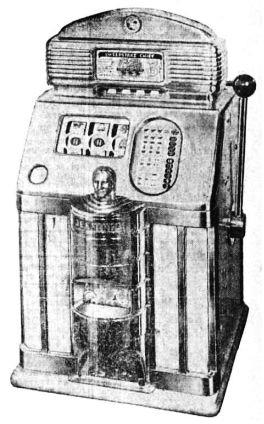
The second arrangement shown on the second line of the diagram is that of the Jennings Sweepstake Chief from 1950, pictured at right. This machine has the style of case introduced in 1949 for the Jennings Sun Chief. Here, the pear was added as an extra symbol, ranking below the orange. Two plums and two bells gave the usual payouts for three plums and three bells, because on this machine, three plums and three bells were alternative jackpots. As well, not shown in the diagram, three horses would pay out 500 coins if they came up when a light on the machine was lit.
How can it sustain such a generous payout schedule? Obviously, the extra pear symbol helps. A set of reel strips for the machine had the following distribution of symbols:
(%) Cherries 3 7 - (&) Pears 6 1 1 (O) Oranges 7 8 1 (@) Plums 1 1 8 (A) Bells 1 1 8 (=) Bars 1 1 1 (^) Horses 1 1 1
However, the payout schedule wasn't actually quite as generous as the one shown in the diagram. The plums on the first two reels, and one of the plums on the third reel, were overprinted with the number 11, and, similarly, the bells on the first two reels, and one of the bells on the third reel, were overprinted with the number 7. Jackpots were not paid on any three plums or any three bells, but only on three 11s or three 7s.
Attempting to calculate its percentage:
Reel Combinations Value Amount
1 2 3 Paid
3 * 13 * 20 = 780 * 3 = 2340
3 * 7 * 20 = 420 * 5 = 2100
6 * 1 * 2 = 12 * 5 = 60
7 * 8 * 2 = 112 * 11 = 1232
1 * 1 * 19 = 19 * 13 = 247
1 * 1 * 19 = 19 * 18 = 342
1 * 1 * 1 = 1 * 100 = 100
1 * 1 * 1 = 1 * 100 = 100
1 * 1 * 1 = 1 * 100 = 100
1 * 1 * 1 = 1 * 100 = 100
----
6721
So even assuming a generous jackpot amount of 100 coins, it pays out 6721/8000 coins, or 84.0125%.
I didn't attempt to include the 500 coin jackpot, since I hav eno way of knowing how often the light which increased the prize for three horses would be lit.
The third arrangement shown in the bottom half of the illustration finally shows an example of payouts for a more modern type of machine, on which an award is made for three cherries in a row.
The arrangement of symbols on the reels of this slot machine, also by Jennings, is:
(%) Cherries 3 7 3 (O) Oranges 7 1 10 (@) Plums 6 1 5 (A) Bells 1 10 1 (=) Bars 3 1 1
and the payment schedule it had was the following:
%.. 3 %%. 5 %%% 11 OOO, OO= 11 @@@, @@= 13 AAA, AA= 18 === 150
Once again, we can attempt to calculate this machine's percentage:
Reel Combinations Value Amount
1 2 3 Paid
3 * 13 * 20 = 780 * 3 = 2340
3 * 7 * 17 = 357 * 5 = 1785
3 * 7 * 3 = 63 * 11 = 693
7 * 1 * 11 = 77 * 11 = 847
6 * 1 * 6 = 36 * 13 = 468
1 * 10 * 2 = 20 * 18 = 360
3 * 1 * 1 = 3 * 150 = 450
----
6943
for a percentage of 13.2125%.
Some machines use an upside-down horseshoe (as is favored to retain the good luck) instead of a melon, and Bally has used a target symbol on some of their slot machines as a jackpot symbol. As well, they made an early slot machine, the Bally Double Bell, where three lemons paid out 6 coins.
A slot machine does not necessarily have to have three reels.
The fourth arrangement on the second row shows the payouts for the Vendet Midget from 1931, and the later Burtmeier Pony from 1934. In order to allow only two reels to produce combinations that had a low enough probability to have payouts comparable to those of a three-reel machine, the two reels each had 38 positions on them instead of the normal 20.
The two machines were nearly identical, thus the Burtmeier Pony was likely the Vendet Midget then sold under another name. Their payout schedule, when used with fruit symbols (reel strips with images of dice in different colors were also available) was:
%% 2 OO 5 @@ 10 AA 15 == 20 + Jackpot
To compensate for having two reels instead of three, it had 38 symbols on each reel instead of 20, allowing 1,444 combinations. While this was less than the 8000 combinations of a conventional three-reel machine, it was more than the 1000 combinations of a three-reel machine with 10 symbols on each reel, so it was adequate.
Interestingly enough, the two reel strips used on this machine were nearly identical; it was not necessary to compensate for having only two reels by making some symbols rare on one reel, and the others rare on the other, in order to reduce the frequency of payouts.
One set of reel strips for the machine was like this:
Lemons 8 8 Cherries 14 14 Oranges 8 8 Plums 4 4 Bells 2 2 Bars 1 1
and so it paid out like this:
14 * 14 = 196 * 2 = 392
8 * 8 = 64 * 5 = 320
4 * 4 = 16 * 10 = 160
2 * 2 = 4 * 15 = 60
1 * 1 = 1 * 120 = 120
----
1052
and thus, even if the jackpot was 100 coins (20 coins were paid in addition to the jackpot), the machine would have paid 1052 coins out of 1444, for a percentage of 27.147%.
It seems bizarre that they chose to make the two reels identical, at the cost of having so many lemons on each reel. The percentage of the machine could have been exactly the same, while reducing the number of lemons, with a trivial alteration:
Lemons 1 1 Cherries 14 14 Oranges 4 16 Plums 16 1 Bells 1 4 Bars 1 1
The version with strips with pictures of dice on them was interesting. The correspondence between slot machine fruit symbols and dice was:
Reel
Color 1 2
----------- - -
Bar Dark Purple 6 5
Bell Brown 5 6
Plum Blue 4 3
Orange Green 3 4
Cherry Mauve 2 2
Lemon Yellow 1 1
so the winning combinations were throws of 11, 7, and 4 the hard way; the colors of the dice shown on the two reels matched, but the numbers on the dice on the two reels with the same color often differed so that the totals on the dice would be appropriate.